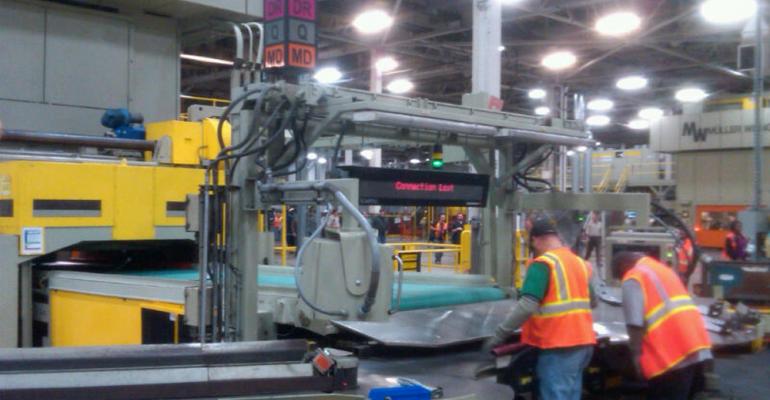PONTIAC, MI – In an example of what General Motors calls its new thriftiness and innovative spirit, the auto maker has put back into service a vacant portion of a localized stamping facility here to turn it into a parts-pressing hub for the Midwest.
The Pontiac Metal Center, about 30 minutes north of Detroit, dates back to 1926 as part of Oakland Motor Car. GM snapped up Oakland during its growth into a multi-brand holding company in the early 20th century.
In 1987, the facility shifted from making cars and trucks to pressing metal and building engines. In 1994, PMC shifted completely over to a regional stamping facility, when the prevailing notion was to feed numerous assembly plants with parts from a single source.
With the sharp downturn in new-vehicle sales during the recession, followed by GM’s capacity-shrinking bankruptcy in 2009, PMC operated at a fraction of its capacity, supplying only the Orion Twp., MI, assembly plant five miles (8 km) up the road and employing about 100 people.
But according to Steve Brock, plant manager for PMC and Orion, the auto maker’s brass saw an opportunity to turn the site back into a regional stamping hub by reopening idled space once used for hydroforming.
GM earmarked $30 million for the transformation, which included the addition of two presses taken out of service at the auto maker’s Parma, OH, stamping facility.
About two-thirds of that investment has been spent, and the site has added the Oshawa, ON, Canada; Lansing, MI, Delta Twp.; and Detroit-Hamtramck assembly plants as customers.
In 2011, the facility shipped 34.4 tons (31.3 t) of stamped steel and aluminum and employment doubled.
“These presses are very flexible,” Brock tells WardsAuto. On this day, they were forming inner rails for the Chevy Impala. “We can continue to bring in additional product until the capacity is filled up.”
The new employees comprise formerly laid-off PMC workers and a combination of temporary and new hires.
The presses are among the fastest in GM’s stamping network, performing 40 strokes per minute using material fed directly off a coil to crank out 10,000 to 15,000 parts in an 8-hour shift. It takes just five minutes to change out the dies.
Two diverters in the floor keep aluminum and steel scrap separate, allowing GM to get its best dollar for the material at recycling centers.
Using existing brick and mortar saved GM millions of dollars in new construction, but it took a bit of old-fashioned Yankee ingenuity to make it happen.
As a former hydroforming site, this portion of PMC didn’t need the overhead cranes a stamping site demands for changing out dies. GM essentially had to choose whether to use another location or poke holes in the roof at PMC.
The auto maker came up with a third, winning alternative. GM took a piece of machinery from the marine industry meant for hoisting boats out of the water and retooled it for the stamping process, using the carrier to shuttle dies through the plant and change them out of the presses.
Typically, the marine hoists would include a driver’s cockpit and rely on a diesel or gasoline engine for propulsion. But for GM’s application, the auto maker swapped in batteries for the internal-combustion engine, and an employee operates the unit via wireless remote.
The Mobile Die Crane rolls on foam-filled tires to handle the weight of the 60,000-lb. (26,136-kg) dies, an idea borrowed from the aviation industry.
“We had to get creative over how we were going to move the dies around in here,” says Steve Lyndrup, launch manager at PMC.
More products are expected for PMC, Brock says. GM has set aside another $13 million to bring the number of presses at the facility to 10, but the auto maker is in no rush, he adds. The timetable for expansion will follow the comeback in new-vehicle sales, but the energy level at PMC is palpable.
“When these presses are running,” Brock says over the deafening crash of the dies that exert 10 tons (9 t) of force with each stroke, “it sounds like a cash register. We’re making money.”




